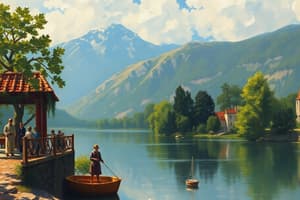Podcast
Questions and Answers
What are the two types of tourism resources mentioned in the text?
What are the two types of tourism resources mentioned in the text?
- Accommodation and transport resources
- Natural and man-made resources
- Tangible and intangible resources (correct)
- Human and financial resources
What are the key attractors in a tourism destination?
What are the key attractors in a tourism destination?
- Human and financial resources
- Culture and hospitality
- Tourism policy and planning
- Accommodation, transport, and destination reputation (correct)
What do human resources in tourism include?
What do human resources in tourism include?
- Skills, motivations, and service levels (correct)
- Qualifications and experience
- Investment capital and training systems
- Tourist facilities and services
What is the purpose of tourism policy?
What is the purpose of tourism policy?
What are the components of tourism planning?
What are the components of tourism planning?
What are the levels of tourism planning?
What are the levels of tourism planning?
What is the purpose of indicators in tourism?
What is the purpose of indicators in tourism?
Flashcards are hidden until you start studying
Study Notes
Tourism Resources: A Summary
- Tourism resources include natural and man-made attractions, infrastructure, services, and conditions that attract tourists to an area.
- Tangible resources include facilities, attractions, and infrastructure, while intangible resources include image, reputation, and culture.
- Human resources such as skills, motivations, and service levels, and financial resources such as investment capital are also part of tourism resources.
- Accommodation, transport, and the reputation and image of the destination are key attractors in a tourism destination.
- The culture of the destination, including welcoming of tourists and hospitality, is also an important intangible resource.
- Human resources include skills, qualifications, experience, work ethics, training systems, and schemes.
- Tourism policy provides a framework for collective and individual decisions affecting long-term tourism development and daily activities in a destination.
- Tourism planning involves making decisions for the future and implementing them, including monitoring outcomes.
- Components of tourism include attractions and activities, accommodation, other tourist facilities and services, transportation facilities and services, other infrastructure, and institutional elements.
- Levels of tourism planning include national, international, and regional.
- Indicators are gauges of current issues, warning signs of impending problems, and can lead to better decision-making, identification of emerging issues, impacts, and performance measurement, reduced risk of planning mistakes, greater accountability, and continuous improvement.
- Good indicators can foster accountability for the wise use of tourism in decision-making.
Studying That Suits You
Use AI to generate personalized quizzes and flashcards to suit your learning preferences.




